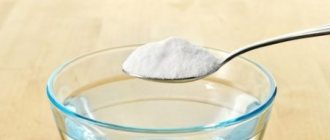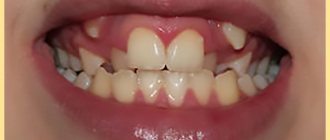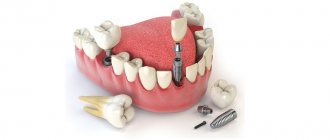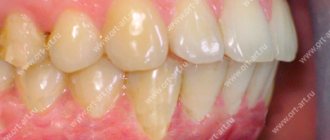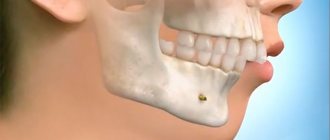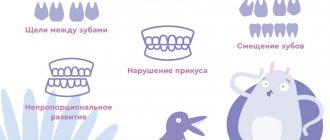The formation of teeth is a complex step-by-step process that begins in the first weeks of intrauterine life. Thus, by the time of birth, the baby has the rudiments of 20 primary and 16 permanent teeth inside each jaw. But, like all stages of development, teething in children under one year and older occurs differently. Some endure this period relatively calmly, others are capricious and sleep poorly. Why this happens and how to understand that the baby is cutting teeth, we will tell you further.
Which teeth exactly have such a strange name?
So, the term “eye teeth” is not a medical term. The correct name for these teeth is upper canines. Where did such a strange name come from? The fact is that in the immediate vicinity of the upper fangs there are threads of the facial nerve. When these threads are irritated, very severe pain occurs in the upper part of the face. This pain even extends to the eyes.
When babies' upper canines begin to erupt, pain occurs that makes children cry. Unfortunately, this process takes quite a long time. Removal of eye teeth in adults is also always accompanied by severe pain. In this case, dentists use very strong anesthesia.
From somewhere there are ridiculous rumors that a person can even go blind from the removal of eye teeth. Such cases are unknown to medicine.
Symptoms
Usually, no serious problems arise during teething, but local (in rare cases systemic) disturbances are present. These include:
- swelling and soreness of the gums;
- profuse drooling;
- irritability;
- restless sleep;
- lethargy;
- the baby's need for biting and chewing;
- poor appetite.
Loose stools, low-grade fever and runny nose are less common than the above symptoms.
Important! If the body temperature rises above 38 degrees, convulsions, difficulty breathing, you need to show the baby to a doctor and call an ambulance. This may indicate a viral infectious disease and is not a sign of teething.
Some parents wonder why this process occurs differently in babies. For example, in some teething occurs with fever, in others it does not. It is noted that, among other factors, this is also influenced by the child’s constitutional type. In children of the allergic type, this period may be accompanied by increased moodiness, atopic dermatitis, and ARVI is often associated. Infants with asthenic syndrome sleep poorly, refuse to eat, and cry for a long time due to severe pain.
External features of eye teeth
Eye teeth are visually very different from both the front teeth and molars. The eye tooth has only one root. It is relatively long and slightly flattened. The crowns of the eye teeth have two cutting edges located at an acute angle to each other. They also have a slightly flattened shape.
The upper eye teeth are noticeably larger and longer than the lower ones. Their cutting surface is much wider than that of the lower canines.
Nature entrusted these teeth to hold food in the mouth and tear food into pieces.
Where to look for the most painful points on the jaws?
Let's look at the schematic arrangement of teeth in human jaws. Often children are born with one tooth already erupted, while in others they appear only at one year of age.
They are lucky: two dozen children's teeth, called milk teeth, do not last their entire lives, and after a few years they are replaced by thirty-two new ones, called permanent ones.
Question: At what age do permanent canines grow in children? Each has a different period, it ends with the thirteenth year.
Each group of teeth on the upper and lower jaws has its own purpose. Some - six in each - cut (bite) food, others tear and hold it, and others chew it. The lower and upper canines in children, there are two of them in each jaw, in structure they are the third from the middle part - between the incisors and molars, in other words, premolars and molars.
Despite the fact that due to their spear-shaped structure and the absence of grooves for the development of superficial infections, they are not affected by very painful caries, especially when fangs are cut in children. But they are the ones that cause the most severe toothache. Or rather, pain from under them, in the gums, often with fistulas, which requires surgical intervention.
This is the difficulty in diagnosing the symptoms of pain: the tooth is intact, does not wobble, and only when tapped does pain occur. But it can also come from the neighboring premolar. Often children even have to have their baby teeth removed.
Formation of eye teeth in children
Children's milk teeth erupt in a strictly defined sequence. Each tooth is waiting its turn to appear in the baby’s mouth.
Children's eye teeth begin to erupt only after all the incisors and first molars have appeared. The upper canines begin to erupt first. This usually happens at the age of one and a half years. The lower canines begin to appear when the baby is 20 months old.
This delay is explained by the fact that the roots of the eye teeth penetrate into the depths of the bone tissue much deeper than the other teeth.
During eye teething, children experience more than just pain. Most of them experience a slight increase in body temperature. Running noses and even swelling in the oral cavity often occur. Young mothers often perceive all this as a child’s illness. Meanwhile, this is a completely natural, albeit unpleasant, process. It cannot be any other way, because at this time the gums next to the baby’s teething teeth become inflamed.
Only in the rarest cases can babies experience coughing, diarrhea and even vomiting at this time. However, these are symptoms of another random disease that has nothing to do with the appearance of eye teeth.
The completion of tooth root formation occurs at approximately this age:
| Teeth | Upper jaw, age | Lower jaw, age |
| Central incisors | 9-13 | 7-11 |
| Lateral incisors | 9-12 | 8-11 |
| Fangs | 9-12 | 9-12 |
| First premolars | 11-13 | 11-13 |
| Second premolars | 11-13 | 11-13 |
| First molars | 9-12 | 9-12 |
| Second molars | 14-15 | 14-15 |
Since the eruption of third molars does not occur at a specific time, it is impossible to establish a clear age at which their roots are formed.
X-ray results confirm the completion of the process of tooth root formation. The key signs are the absence of an opening at the apex, as well as a pronounced periodontal contour.
Thus, completion of dental growth, including full maturation, usually occurs only between the ages of 15 and 18 years. It is at this time that the maxillofacial apparatus already has the same dimensions as in adults.
How to ease the baby's suffering?
It is impossible to ensure completely painless eruption of eye teeth. However, you can help your baby in several ways.
A light massage of the gums slightly dulls the pain. In any case, this stops the kids from crying. To do this, you need to gently stroke the gum just above the eye tooth for a couple of minutes. This massage can be done two to three times a day.
Now pharmacies sell special teethers. Before using, keep them in the refrigerator for a while. These simple products are filled with distilled water. If the baby bites through the shell, then nothing bad will happen.
You can dull the pain with the help of anesthetic gels Dentinox, Kalgel or Kamistad. They begin to act a few minutes after application to the gums.
If the baby’s nose is stuffy during the teething of the eye teeth, then in this case it is worth using drops of Otrivin, Nazivin or Quix. They tend to constrict blood vessels. It also happens that the body temperature of babies rises to 38 degrees or higher. In this case, you have to resort to antipyretic children's drugs paracetamol or ibuprofen. They are available in the form of syrups or candles.
If the baby is having too much trouble with the teething of the eye teeth, then in such a situation it is better to call a pediatrician at home.
Crooked teeth
If permanent teeth begin to grow unevenly, you need to come for a consultation with an orthodontist at the A-Medic Network of Medical Clinics as soon as possible. The sooner such a decision is made, the easier it will be for the dentist to correct their growth. An incorrect bite is not only inconvenient, it can lead to the development of a number of diseases, for example, caries, stomach diseases, and cause childhood and teenage complexes and psychological problems.
The easiest way to straighten your jaw is to wear braces. It is very important for parents, together with the attending physician, to explain to the child that temporary inconveniences when using braces are justified and will bring invaluable benefits in the future. You need to take good care of it, because it will stay in your mouth for at least six months. This design will work most effectively during adolescence. Small children can more easily tolerate plates or trainers, which look something like boxing mouthguards, rather than braces. Children's enamel is quite delicate, so trainers that do not damage it will be the best way to correct a child's malocclusion.
Eye teeth in teenagers
The permanent lower eye teeth are formed at the age of 9-10 years. The upper fangs appear after 1-2 years.
In a healthy child, the formation of permanent eye teeth is painless. If this process is accompanied by pain, then this indicates a serious problem. This usually happens if diseases of the oral cavity occur, such as gumboil, pulpitis, periodontitis or other inflammatory processes. In such a situation, you should not try to get rid of the problem yourself. The most you can do is take a painkiller and immediately go to the dentist.
Treatment of dystopic upper canines
The upper canines are critically important teeth for the dentition, given the characteristics of their morphology, position, protective function in the structure of occlusal interactions, as well as the volume of visualization in the smile profile. The proper position of the canines in the dental arch is one of the criteria for the predicted stability of the results of dental treatment.
Dystopia and tooth retention can develop due to physical blocking by other teeth, thickening of bone tissue or mucosa due to the presence of supernumerary teeth, odontoma or some other tumor. The third molars of the lower jaw are characterized by the highest prevalence of cases of dystopia and retention, while the second place is occupied by the canines of the upper jaw. During eruption, the upper canines must travel a significant distance from the lower edge of the orbit to the edge of the bony ridge when all other anterior teeth have already erupted. The prevalence of dystopia and retention of the upper canines is about 2%, and among women this pathology occurs 2-3 times more often than among men. About 66% of cases of dystopia and retention of the upper canines are situations with their displacement in the projection of the palate, while the remaining 33% fall on dystopia in the vestibular position. Bilateral dystopia is noted with an 8% prevalence rate. In Latin American countries, according to publications by authors from Colombia, Mexico and Brazil, the prevalence of canine dystopia is almost the same as in Europe or the USA. However, countries such as Greece or Turkey, for example, are characterized by a slightly higher level of registration of cases of the above-mentioned pathology (at a rate of approximately 4%).
Dystopia of the upper canines can cause displacement of other teeth, cyst formation, resorption of the roots of the lateral incisors (especially when their roots are oriented palatally), the development of localized and widespread pain, as well as inflammatory disorders. Clinicians should be aware that there may be a difference of up to 6 months between the child's chronological age and the age of canine eruption to ensure that there is no developmental or eruption disorder. Only the clinical sign of the absence of a canine tooth in the dentition at the age of 12 years is not a dominant criterion for making any diagnosis. Timely diagnosis and appropriate interventions allow a more optimal approach to the issue of proper occlusal correction. If early interventions are unsuccessful, a multidisciplinary approach to treatment may be necessary, which involves the implementation of surgical and orthopedic phases of intervention.
Causes of dystopia
Potential causes of dystopia suggested by Becker and Chaushu include: increased size of the tooth germ, odontoma, the presence of an unerupted tooth in the path of the problematic unit of the dentition, delayed eruption of adjacent teeth, and the presence or absence of lateral incisors. Three main criteria must be considered to properly evaluate dystopic maxillary canines: diagnostic principles, treatment plan, and biomechanical principles. To adequately assess the existing disorder, it is necessary to use both clinical and radiological diagnostic methods. The treatment plan for canine dystopia often involves close collaboration between the orthodontist and the oral surgeon. The implementation of biomechanical principles must take into account the possibilities of effective application and orientation of orthodontic force vectors for therapeutic purposes.
Bishara conditionally divided all the causes of dystopia into local and general. Among the common causes, the author identified disorders in the structure of the thyroid gland, hypovitaminosis of vitamins A and D, infectious diseases, radiation, and several syndromes, including Crouzon syndrome and Down syndrome. Local causes of dystopia include the presence of supernumerary teeth, odontomas, trauma at an early age, cleft lip or palate. Other potential causes are associated with abnormalities in the morphology or position of the tooth germ, disturbances in the eruption path of the canines, ankylosis of the periodontal ligament, prolonged retention or, conversely, too rapid loss of primary canines, iatrogenic causes, bifurcated roots, or the influence of idiopathic factors.
It is generally accepted that the specific cause of buccal retention of the maxillary canines is a lack of space in the dentition or insufficient length of the dental arch. Tomographic studies have demonstrated a relationship between narrow maxillary shape and buccal canine retention. But similar associations were not found for palatal dystopia and maxillary canine retention. Jacobs reported the influence of tooth size discrepancy on the possibility of developing impaction of canines, with canines being more prone to such problems due to their significantly longer eruption path compared to other teeth. Becker suggested that palatal retention of the canines may be caused by a lack of direction from the roots of the lateral incisors (in the absence or morphological deformation of the latter). Other authors have cited genetic causes behind canine impaction, including microdontia of the lateral incisors, enamel hypoplasia, defective eruption of primary molars, or distally disrupted eruption patterns of second premolars. Peck et al associate palatal dystopia and canine impaction with a broader set of chromosomal abnormalities.
Planning of surgical/orthodontic interventions and algorithm for selecting them
To help clinicians determine the optimal treatment method for maxillary canine impaction, an algorithm for selecting surgical and orthodontic types of interventions will be presented below.
Diagnosis of canine retention
The diagnostic process should follow a logical sequence and include a detailed analysis of personal and family history of existing dental disorders, the results of a comprehensive clinical examination, which in turn includes: palpation, X-ray screening through orthopantomography, lateral cephalography and radiography in the superior occlusal projection. It is also recommended to obtain additional targeted images using the Clark method, although from the point of view of cost-effectiveness, orthopantomography is a more reasoned diagnostic approach. For a more detailed analysis, you can use the method of cone beam computed tomography. The latter makes it possible to diagnose root resorption of adjacent teeth, possible transposition between the lateral incisors and canines, as well as the trajectory of the eruption of the canines in cases of its projection over the apical areas of the lateral incisors. In addition, CBCT can identify root splitting and signs of ankylotic changes. According to Ericson and Kurol, CBCT data confirmed evidence of root resorption in 38% of maxillary lateral incisors and 9% of maxillary central incisors due to canine impaction (Figures 1 and 2).
Photo 1. Scan of palatally impacted canines (front view).
Photo 2. Scan of palatally impacted canines (occlusal view).
CBCT method and canine retention
As a valuable X-ray diagnostic tool, the use of CBCT is indicated depending on the amount and nature of the information that the doctor received during the clinical examination. The use of CBCT must be justified taking into account the individual needs of each individual patient. This means that CBCT should not be considered as the first imaging modality in the absence of clinical suspicion of maxillary canine impaction. Localized CBCT imaging is only warranted after careful clinical evaluation and in cases where other radiographic diagnostic modalities do not provide the necessary data to identify or differentiate the pathology. Although it is intuitive to assume that 3-dimensional imaging is certainly superior to 2-dimensional imaging, this assumption has not been completely unambiguous in cases of impacted canines. Systematic reviews comparing diagnostic approaches to the verification and assessment of canine impaction using CBCT and traditional imaging methods have shown that, although CBCT leads to greater consistency in diagnosis, the choice of different treatments for the same pathology by different clinicians - dentists continues to vary. In other words, CBCT does not eliminate differences in existing personal treatment preferences among dentists. Therefore, orthopantomography in many cases remains the most appropriate method of radiological diagnosis. A similar conclusion was reached in studies of angulation and position of impacted canines: although CBCT allows a more accurate assessment of the above-mentioned parameters, the treatment plan for this disorder varies significantly among different dentists, that is, the level of patient-centered effectiveness of impaction treatment canines remains quite low, despite the fact that the tomographic method is used. In summary, there is no convincing evidence that CBCT should be considered a first-line diagnostic modality for assessing maxillary canine impaction, although its use is indicated in cases where 2D diagnostic results do not provide adequate diagnostic information.
Open or closed surgical technique?
In a systematic review of the literature examining treatment options for high palate impacted canines, Parkin et al concluded that the available evidence does not support the conclusion that closed versus open surgical techniques are superior when compared. None of the above-mentioned techniques was characterized by a better treatment outcome in terms of gingival aesthetics, dental health and patient comfort. The authors recommended more detailed randomized trials. In another systematic review, Sampaziotis et al compared the effectiveness of open and closed operative approaches for the management of impacted maxillary canine teeth. The researchers also concluded that the difference in periodontal and esthetic outcomes between the two treatment methods was not significant. The level of postoperative discomfort in patients of both comparison groups was similar. The only difference was that the open surgical technique required less time, although this conclusion was based on the results of only two studies analyzed. In a systematic review with meta-analysis, Cassina et al concluded that the open surgical approach has a lower risk of ankylosis and a shorter required traction period for impacted canines. It should be noted that this systematic review analyzed only a small number of clinical studies. To formulate targeted clinical recommendations regarding the choice of a particular treatment method, the researchers recommended conducting controlled randomized trials. The disadvantage of the method of closed induced eruption of canines is that if the orthodontic appliances used lose stability, additional surgical interventions are required. In addition, since the tooth is located inside the bone tissue, it is much more difficult to control the force vector, therefore, traction is essentially a blind movement. In addition, in cases of closed type interventions, the risk of developing ankylosis increases. This is why many doctors prefer the technique of open canine movement, although no consensus decision on this matter has yet been formed.
Consideration of location early in the treatment of impacted canines
Removing a temporary canine is the simplest method of preventing the development of retention of permanent canines. This manipulation can be performed in isolation, or in combination with the use of a place holder, such as a Nance button or a maxillo-palatal arch. In some cases, a device can be used to expand the dental arch. Jacobs emphasized the importance of correcting the lack of arch space in the upper jaw, and Baccetti, in turn, noted the importance of early expansion of the palate during the mixed dentition period to prevent the development of early signs of retention. Palate expansion is an effective and cost-effective method of restoring arch width to avoid future bite problems. Pediatric dentists should recommend orthopantomographic examination for patients aged 7 to 11 years. According to orthopantomography data, it is possible to objectively assess the proximity of the canine crown in relation to the roots of the lateral and central incisors. After removal of temporary canines, the clinical situation can significantly improve even with signs of resorption of the roots of the lateral incisors. However, you need to understand that early extraction of primary canines does not always work.
In a randomized clinical controlled trial, Naoumova and Kjellberg provided a clear algorithm for the temporary removal of primary canines. When potentially impacted permanent canines are located in sector 2 (between the distal surface of the lateral incisor and the midline of the lateral incisor) or in sector 3 (between the midline of the lateral incisor and the distal side of the central incisor), and their conventional inclination to the vertical plane is 20-30 degrees , removal of temporary fangs is indicated for prophylactic purposes. In cases where the inclination is less than 20 degrees or more than 30 degrees, the extraction of temporary canines will not significantly affect the result of retention of permanent teeth. The same applies to permanent canines impacted in sectors 1 (deciduous canine), 4 (distal central incisor to midline of the central incisor), or 5 (midline of the central incisor to midline of the maxillary arch). The exposure and direction of impacted canines from the surfaces of nearby tooth roots is carried out surgically. The authors proposed to advance the canine first palatally or buccally, depending on the situation, and then distally. In patients with severe crowding, it is recommended to evaluate the response of the impacted canine to traction before deciding whether to remove a premolar.
Recommendations for anchoring impacted teeth
For orthodontic pulling of impacted teeth, a stainless steel arch with a rectangular cross-section or a thick transpalatal beam of a sufficient level of rigidity is used. The use of these traction materials is extremely important in cases of palatal impaction of canines. In the process of orthodontic treatment of these teeth, it is necessary to abandon the use of flexible arches, since their action can provoke the development of undesirable side effects in the area of adjacent teeth during the process of canine traction. Sufficient intra-arch anchorage can be achieved by using 0.019 x 0.025 orthodontic wire in a 0.022 slot. This approach prevents arch deformation, open bite changes, intrusion of adjacent teeth and ensures the prevention of associated complications. Swing gate expanders, transpalatal arches, Hass expanders, quad coils, Hyrax expanders and orthodontic implants can be used as external elements as alternative fixation options. In cases where a transpalatal beam is used, its mechanism of action is to use cantilever extensors to pull the affected canine into the projection of the palate. After this, the canine is directly pulled out and its position is normalized using positional arches (photo 3-4).
Photo 3. A swinging gate-type device for direct traction of palatally impacted canines during the implementation of the open surgical method.
Photo 4. Exposure of a palatally impacted canine. A transpalatal bar was used as an anchor with an additional handle to provide traction on the canine.
Recommendations for activating impacted canines
The vectors of force acting on the canines should ensure their displacement away from the roots of adjacent teeth, especially in cases where impacted teeth are adjacent to the roots of the lateral incisors. With deep palatal retention, activation of the canines must occur first occlusally and then distally to achieve the required position in the dental arch. Elastic chains or threads, nickel titanium springs, extrusion assist springs, ballista springs, cantilever arms, and orthodontic implants may be used to enhance traction. If the development of ankylosis is suspected, the traction force should be reduced and the patient should be referred to a periodontist. In such cases, it is recommended to obtain a plain periapical x-ray to evaluate the presence of osteoid tissue to ensure that the periodontal tissue follows the tooth as it advances.
Treatment time for impacted canines
In assessing the duration of orthodontic treatment, Fink and Smith reviewed six private orthodontic practices and 118 case reports of patients without evidence of canine impaction and concluded that the average orthodontic treatment time was approximately 23.1 months, with a range of 19.4 to 27.9 months. . Another study evaluated the duration of treatment in adolescents with palatal impacted canines using closed orthodontic eruption. In cases of unilateral retention, the average treatment time was 25.8 months, while in cases of bilateral retention it increased to 32.3 months. A similar study was conducted among adults with palatally impacted canines who were treated with the same protocol. The treatment success rate in adult patients was found to be 69.5%, compared to the 100% success rate reported among adolescents. Another interesting discovery was that in all cases of unsuccessful treatment for non-eruptive canine pathology, the age of the patients exceeded 30 years.
The orthodontist is often faced with the problem of creating sufficient space in the dentition before pulling out the canines. This preparatory stage of treatment can take from 2 to 4 months. The position of problematic canines can be assessed by palpation, radiography, or transmucosal probing. Palpation of the unerupted canine allows the doctor to feel a hard, well-defined area that can be used to determine the location of the impacted tooth. If this bulge cannot be detected, an x-ray may be necessary. For this purpose, lateral, occlusal, panoramic and periapical imaging techniques are used. During radiographic assessment, the SLOB rule (“same-lingual, opposite-buccal” - same-lingual, opposite-buccal) is often used: on two images of the same area, taken at different angles of the tube, it is determined in which direction visually “ the problematic tooth moves. For the purpose described above, the method of cone-beam computed tomography can also be used for greater diagnostic accuracy.
Intervention techniques for vestibular retention of canines
Approximately a third of all clinical cases of canine retention occur due to their vestibular transposition. In such cases, use one of the two intervention techniques described above:
1. Gingivectomy, which is essentially the cutting out of gum tissue. In this case, the tip of the canine should be at or below the mucogingival junction. This procedure is indicated when there is a wide area of keratinized gum tissue. It is performed with a special Kirkland knife or a 15th blade with an external bevel. If the canine tip is located coronal to the cemento-enamel junction of the lateral incisor, this is another indication for gingivectomy. At the end of the procedure, at least 3 mm of keratinized gingiva should be accessible apical to the level of the cemento-enamel junction. To place a bracket, at least two-thirds of the surface of the canine crown must be exposed. The disadvantage of this intervention is that the procedure may need to be repeated when the gum tissue is restored, or if there is not enough keratinized gum.
2. The method of creating an apically repositioned flap is an intervention option for a deficiency of keratinized gingival tissue, and is preferable in cases where the canine is localized mesial to the lateral incisor. The flap must be secured and adapted to the tooth. Contraindications to an apically repositioned flap include the risk of gingival recession and irregular gingival margins, as well as the potential need for extensive bone grafting. The primary incision is made using a 15 c ridge projection blade in order to obtain the maximum volume of keratinized gums. After this, vertical incisions are made and the flap is moved in a lateral or apical direction. The design of the flap provides for the same width of the base and the coronal part of the flap, or the base can be slightly narrower; The flap thickness should be 4-5 mm to ensure proper width in the mesiodistal direction, extending to 1.5 mm beyond the corner of the tooth (Figure 5-6). The bone covering the impacted tooth must be removed with a curette or bur to expose the crown surface. The flap is then positioned at the cemento-enamel junction and secured with sutures to ensure proper stability. Depending on the level of retention, a periodontal bandage can be used to prevent overgrowth of soft tissues. The bracket is installed during the flap formation procedure, or after 10 days. If the impacted canine is too apical, a closed orthodontic eruption technique is used. The orthodontic phase in this case begins 4-6 weeks after surgical exposure. In cases where the canine is surrounded by a wide follicle, the flap incision must be made wider than the size of the follicle in order to achieve proper subsequent adaptation of the flap to the tooth and bone tissue. If the flap is adequately adapted, it will not move when the lip moves.
Photo 5. Application of an apically displaced flap during the treatment of bilateral canine impaction. During the manipulation, the median frenulum was cut out and braces were installed.
Photo 6. After the orthodontic phase of treatment, the canines were positioned in the dentition.
Surgical methods for treating palatal impaction of canines
Two surgical approaches can be used to expose palatally impacted canines: an open approach with a trapezius or lunate flap, or a closed approach.
Open surgical method. A semilunar oblique incision is made with the 15th blade or 15c blade from the mesio-palatal side of the tooth, continuing it to the distal palatal side. The incision is made to the entire depth of the tissue to the bone, after which the full-tissue flap is separated using a periosteal elevator. The bone covering the canine is removed using a curette or rotary instrument. The follicle is cut out and scraped to completely expose the fang, creating conditions for fixing the bracket. A ligature is attached to the bracket for traction. Hemostasis is ensured by local anesthesia, bone wax, or a sponge soaked in an anesthetic solution with an adrenaline concentration of 1:50,000. To fenestrate the gum tissue in the projection of the bracket, a new 15c blade is used, thus, as if forming a window for access to the bracket through a flap that is fixed with sutures. A periodontal dressing is used if necessary. In cases where it is necessary to apply direct traction, orthodontic force is applied 2 weeks after the operation; before that, the tooth is given a chance to erupt independently in the direction of the occlusal plane, after which its position in the dentition can be corrected (photo 7-8).
Photo 7. Spontaneous eruption of impacted canines 7 months after surgical exposure.
Figure 8. After the canines had erupted to the level of the occlusal plane, they were placed into the dentition using orthodontic traction. The total duration of treatment was 12 months.
Closed surgical method. When performing this manipulation, an intrasulcular or crestal incision is made with the 15th blade or 15c blade from the premolar to the midline. The full-tissue flap is separated using a periosteal elevator to expose the impacted tooth. Any residual tissue that interferes with the eruption of the canine is removed by curettage. After fixing the bracket and installing the ligature, the flap is fixed into place. The advantage of this approach is the preservation of gingival aesthetics, but the disadvantage is the possible peeling of the bracket due to the lack of dryness of the working field during its installation. Consequently, in some cases there is a need for additional surgical intervention.
Complications during surgical/orthodontic treatment of impacted teeth
Complications that orthodontists may encounter when treating impacted teeth include devitalization, the need for re-exposure, ankylosis, damage to adjacent teeth, and external root resorption. An adequate treatment protocol preserves the integrity of the periodontal attachment. To date, there are no studies explaining the difference in treatment outcomes for impacted canine teeth between adults and adolescents. It has been suggested that the periodontal ligament around unerupted canines atrophies in older patients, thereby slowing their ambulation and making it less predictable. The use of CBCT allows a comprehensive assessment of the morphology of the tooth and root, as well as the surrounding periodontal complex. In cases where there is no ligamentous space or with a hook-shaped apex, more careful planning of the intervention is necessary to avoid the development of ankylosis. The prevalence of ankylosis increases with age, therefore the possibility of successful treatment of impacted canines decreases. Patients should be informed about the risks and benefits of treatment for ankylosed canines so that they can choose between orthodontic treatment and possible extraction or further implantation.
Adverse reactions from the periodontium
An appropriate surgical approach is critical to predict the soft tissue and periodontal condition during the treatment of impacted canine teeth. Rapid movement, heavy loads and poor oral hygiene are most responsible for a possible negative reaction to periodontal treatment. Marginal bone loss, gum recession, and sensitivity are complications of long-term orthodontic treatment. To optimize treatment time, some doctors suggest using approaches with the formation of perforations and tunnels, although other specialists consider these approaches to be periodontally compromising. After all, if during treatment it is nevertheless possible to position the canine into the required position, then the patient will be left with a periodontal defect that requires augmentation intervention to restore the integrity of the tissues.
Root resorption of impacted canine and/or adjacent teeth
In conventional orthodontic treatment of non-impacted teeth, the risk of root resorption is directly related to the duration of treatment. At the same time, the anterior teeth of the upper and lower jaws are more sensitive to the risk of developing root resorption. Other factors associated with a greater likelihood of resorptive damage are anterior retraction, extraction of teeth, significant orthodontic forces and irregularities in the shape of the apical region of the teeth. Remington et al followed a large sample of patients for 10 years after completing their treatment. They concluded that if the development of resorption is associated with treatment, then stopping the movement of teeth under the influence of orthodontic traction will most likely stop the resorptive process.
Ericson et al reported that the likelihood of lateral incisor root resorption was 3 to 4 times higher in women than in men treated with impacted canines. In addition, the diagnosis of resorptive pathology in women using CBCT is more accurate than in men. In general, CBCT can identify 50% more cases of root resorption than 2D x-rays. It is still not completely clear what the mechanism of resorption of the roots of the lateral and central incisors is in cases of treatment of canine retention. Perhaps it is caused directly by the movement of the fang and its pressure on adjacent structures; on the other hand, the cause of the pathology may be an enlarged tooth follicle. Yan et al reported a correlation between the development of root resorption of adjacent teeth and a distance of less than 1 mm between the root resorption and the impacted canine. Dağsuyu's studies could not find any associations between the size of the canine follicle and the resorption of the roots of the lateral incisors. However, the authors reported that lateral incisors with signs of resorption were in close contact with more asymmetrical and enlarged canine follicles. Chaushu stated that when the canine follicle size is greater than 2 mm, the risk of developing root resorption of adjacent teeth significantly increases. If there are signs of resorptive damage to the root of the lateral incisors (even in conditions of only half the formation of the canine root) in patients aged 9-10 years, it is recommended to expose the canines and shift them away from the adjacent teeth. After such distalization of the canines, no orthodontic forces act on them for some time in order to create conditions for the full development of the root. Movement of problematic canines away from incisors with signs of root resorption may promote restoration of cementum over exposed dentin. If there is resorption of the buccal or palatal surface of the root of the lateral incisors, it should be diagnosed before treatment. Pre-existing resorptive lesions rarely cause loss of central or lateral incisors, but require special attention. Vermette found that the roots of impacted canines, after they had fully moved into the dentition, were shorter than normal ones. The most pronounced resorptive signs were found on canines impacted in the middle of the bone crest. In many cases, root resorption can be avoided by physiological movement of the lateral incisors during canine traction.
Summary
Although impaction of the maxillary canines is relatively uncommon among the general population, the frequency of registration of this pathology among dental patients is quite high. Canine impaction requires an integrated approach to diagnosis and treatment. Some clinical cases of canine retention can be solved by removing their deciduous counterparts and using “place holders” - special orthodontic appliances. If it is not possible to achieve an effective result through minimally invasive interventions, then complex surgical and orthodontic treatment is resorted to. This article describes protocols for surgical and orthodontic treatment techniques for cases of palatal and vestibular canine impaction. The doctor must independently choose the most optimal approach, based on the characteristics of the clinical situation and the evidence base. In case of buccal retention, special attention when choosing a treatment method should be paid to the position of the canine relative to the mucogingival border. To correct such clinical cases, gingivectomy, apically positioned flap, or closed surgical technique can be used. For palatal retention of canines, the open surgical method has many advantages over the closed surgical method. However, the latter also has its own specific indications. The use of proper orthodontic traction techniques and consideration of basic biomechanical principles significantly reduces the risk of developing iatrogenic complications. The following three factors are critical to orthodontic success: adequate anchorage in the maxilla, use of an effective bonding protocol, and application of adequately targeted forces of optimal magnitude to provide traction. Possible complications that may be noted during the treatment of impacted canines include the development of ankylosis, resorption of the roots of adjacent teeth, disruption of the gingival aesthetics in the projection of the canines, and the potential need for excessively prolonged treatment.
Authors: Miguel Hirschhaut, DDS Nelson Leon, DDS Howard Gross, DDS, MS Carlos Flores-Mir, DDS, DSc
Teething order
The timing of the appearance of permanent teeth to replace lost milk teeth is generally the same for all children and adolescents. After the child turns 5 years old, the first large molars make themselves felt. Then the central incisors are replaced from below, then the same teeth from above, and the lateral incisors from below. At 8-9 years of age, the lateral incisors on top are replaced. From 9 to 12 years of age, all small molars are replaced. At 13, all fangs are replaced. After 14 years, second large molars appear on all sides, which were not there before. By the age of 20-22, “wisdom teeth” finally appear. There are cases when during the rest of their lives they never erupted.
What not to do?
The following rules will help you avoid bite problems and the appearance of various defects:
- do not allow your child to loosen his teeth if they are not yet going to fall out and are firmly in place;
- teach your child not to touch a loose tooth with dirty hands (and, of course, he should not pick the hole when the tooth has just fallen out);
- Do not give your child a lot of solid foods during the period of bite changes. This way he can break a baby tooth;
- do not fill the hole after tooth loss with alcohol;
- You shouldn’t make fun of your child’s temporary toothlessness.
When permanent teeth do not appear for a long time
The absence of permanent teeth for too long can be due to several reasons: these are the genetic characteristics of the body, their immaturity, and the destruction of tooth germs by some kind of infection.
Only a dentist can determine the true cause. At the A-Medic Network of Medical Clinics clinic, they will take a picture of the jaw, which will show how the child’s permanent teeth are formed. Sometimes they can grow inside the gums. If nothing is visible on the image, the doctor may suggest solving the problem by installing dentures.
Where to put baby teeth after they fall out?
The first tooth can be kept as a souvenir or given to the child to put in a box with children's valuables. If sentimentality is not accepted in your family, then the tooth can be thrown out.
In many families, the tooth is placed under the pillow to be taken away in exchange for a coin or small treat by the Tooth Fairy. This character came to us from the West. The fairy builds a castle from children's teeth in which good dreams are born.
But there is also a domestic tradition - to give a lost tooth to a mouse, which can also thank you with a gift. Previously, the tooth was thrown underground or hidden behind the stove with the words “Here, mouse, a bast tooth! Give me a bone one, mouse!” Now this story is more suitable for residents of private houses. It's up to you to decide whether it's worth chasing a mouse into an apartment on the 20th floor, even if it's a fabulous one. But you can take absolutely any magical character that your child likes and come up with a story about where and why the baby’s tooth will end up.
Interesting fact: baby teeth contain both stem and progenitor cells. Scientists believe that in the future, with the development of science and technology, baby teeth can be used for the benefit of their owners, for example, to treat serious diseases. But in order to preserve the cells in the tooth, special storage conditions are required, which, unfortunately, cannot be created at home.
Possible abnormalities in the child
Parents should know when to expect changes in their child's bite . Late change of baby teeth, like premature change, is undesirable. They speak of lateness when an eight-year-old child has not yet lost any of his incisors; they speak of early eruption if a five-year-old child has already lost many of his incisors and fallen out. It is important to find out the cause of the changes occurring and, if possible, eliminate it.
Factors due to which the bite changes earlier than standard periods:
- severe jaw injuries;
- congenital diseases leading to anomalies in the eruption of temporary and permanent units;
- advanced caries, due to which crowns and roots are destroyed faster than necessary.
As for a late shift, it is possible due to:
- rickets, calcium and vitamin D deficiency in the child’s body;
- hereditary characteristics of the dentofacial apparatus;
- some infectious pathologies.
Causes for concern
However, in some cases, irregular teething requires medical intervention. Firstly, children have so-called natal and neonatal teeth: if your child was born with teeth or they erupt in the first month of life, you should immediately consult a dentist. As experts explain, these teeth can be additional, or supernumerary, or complete, but erupted very early. They are distinguished by great mobility. If the dentist determines that the teeth are supernumerary, he or she may recommend removing them.
Also, a visit to the dentist may be necessary in case of congenital absence of teeth, or hypodontia. According to researchers from the Kazan State Medical Academy, the absence of incisors or first molars of the upper jaw is extremely rare; Heredity plays a significant role in the development of this deviation.
As soon as your baby's first teeth emerge, start using a special baby toothbrush with a small head and very soft bristles designed to gently but effectively clean baby teeth. Teach your child good oral care from an early age, and be sure to schedule a visit to the dentist between the eruption of the first tooth and your baby's first birthday.
Injuries
An accident or incident, such as a fight, can cause a tooth injury. And it doesn’t matter whether a small part has broken off, or the tooth has cracked, as they say, “to the point of bleeding” - the help of a doctor is definitely needed. In some cases, lost dental tissue is replenished. If a tooth is broken into pieces, it will most likely need to be completely removed and a prosthesis replaced every year. And the answer is simple - the dental tissues have not yet fully matured, the body is growing. And it is necessary to take full care of your teeth at such an early age. In case of extension, the operation is performed by introducing composite materials that replace enamel and dentin.
Mouthguard as a preventive measure for the second dentition
In dental practice, mouth guards are worn by children over four years of age. At this age, the child is already consciously approaching wearing a trainer and can wear it for a long time. The device is made according to individual casts, taking into account the characteristics of jaw development. The material from which the mouthguard is made is soft and does not injure the mucous membrane.
From the age of two, children can wear removable plates to correct bad habits. If a child often sucks a pacifier or fingers, his bite does not develop properly. These children are more likely to have teeth growing in two rows. A soft plate will help avoid this.
In our clinic, parents trust doctors with their most valuable asset – their children. You can rely on our specialists in any situation. To confirm these words, we publish reviews from our grateful clients.
Natadent specialists know how to win over the youngest patients. Most guys leave the dentist's office without the same fears. True professionals in their field not only master their tools flawlessly, but also make every trip to them as comfortable as possible.

